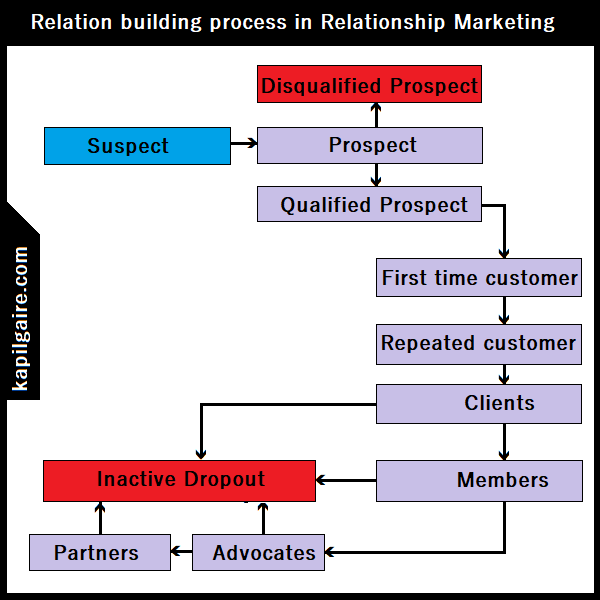Direct Marketing
Direct marketing is the selling products or services directly to the ultimate buyers by mail order or telephone selling or internet rather than through intermediaries. It is the method of selling directly to the end buyer from the manufacturer without the help of intermediaries or channel members. Direct marketing helps to establish a long-term profitable relationship with customers. The immediate reaction is expected from customers in direct marketing. Direct mail, catalog, telephone, television, and internet, etc. are widely used in direct marketing. Recently, direct marketing has become wide and popular. Producers, sellers, service companies, non-profit organizations, catalog merchant, etc. use direct marketing.Direct marketing is marketing through various advertising media that interact directly with consumers, generally calling for the consumers to make a direct response. In direct marketing, marketers use advertising to contact consumers who, in turn, buy products without visiting a retail store. Thus, it is the method of selling directly to the ultimate customers.
Features of Direct Marketing
- Intermediaries free: Direct marketing is intermediaries' free marketing. The exchange takes place keeping direct contact between marketers and customers through different media. There are no middlemen in direct marketing. This method is cost effective. Customers get a quality product at a reasonable price in direct marketing.
- Customer Oriented: Direct marketing establishes a long-term profitable relationship with customers. the marketers give more emphasis on the wants, needs, and requirement of each customer. It is one-to-one on marketing. As the producers remain in direct contact with customers, they make marketing mix keeping the customers at the center. Thus, direct marketing is customer orientated marketing.
- Several forms: There are many forms of direct marketing such as direct mail and catalog marketing, telemarketing, television marketing, internet marketing, etc. Marketers make direct contact with customers in these forms of marketing.
- Direct channel: Direct marketing is direct channel marketing. Producers directly deal with ultimate buyers. Customers also keep direct contact with producers through different media. There are no intermediaries.
- Direct contact: There is a direct channel in direct marketing. Since no middleman, direct contact is established between producers and ultimate customers. Producers keep direct contact with customers one by one. This makes easy for the producers to know about the purchasing power, wants, and need of the customers.
E-marketing
E-marketing refers to the application of marketing principles and technique by electronic media and more specifically the internet. E-marketing in the process of marketing a brand or product or service using the internet. It includes both direct response marketing and indirect marketing elements in use a range of technologies to help connect business to their customers. E-marketing helps to have direct contact with every ultimate customer individually. It also helps to maintain a long-term profitable relationship with customers.E-marketing is a type of direct digital marketing that uses the electronic device as the marketing communication delivery method. It is used in a number of ways by organizations and marketers for the brand and customer loyalty building, acquiring or converting customers, company advertisements, or for communicating promotional offers, and more. It helps to have direct contact between producers and customers through electronic media. Producer, seller, bank, transportation, hotel, and other organizations put full descriptive of products on the internet or online or website. Customers look at the online, and selects products or services given on it, and place an order for delivery. Customers look at the catalog on the personal computers at their homes. Suppose, any customer want a CD player, he/she looks at all brand CD players and selects it and buy the desired one through online service. E-marketing is suitable for cars and other means of transportation, hotel booking, airways ticket booking, books, magazines, clothes, equipment and so on.
E-marketing is is the fusion of information technology with traditional marketing. It uses information technology in the process of creating, communicating, and delivering value to the customers. E-marketing is bigger than web; it uses many software and hardware not related to the web. It uses the internet to do one or more of the following: to communicate a company's message about itself, its products and services, to conduct research as to the nature of existing and potential customers, and to sell products or services.
Features of e-marketing
- Online selling: Products or services are sold through online in e-marketing. Producers, sellers, banks, hotels, transport companies, and, other organizations put catalogs of products or services on the internet. Customers look at such catalogs and place an order for the products and services they have selected.
- Elimination of middleman: E-marketing is direct marketing. There is no role of middleman. Producers or sellers directly deal with ultimate customers one by one through this electronic media. Thus, e-marketing is cost-effective.
- Data depository: E-marketing is online based marketing. Millions of data can be stored and kept in electronic devices. They can be looked, taken out or studied as whenever needed. Producers, sellers, banks, transport companies, and other organizations keep such information and the customers can easily look at them at their home on the internet.
- Enhance promotion: Full details of products or services are available online on producers' websites. It is itself an advertisement. It acts as a promotional tool. It is more attractive and effective. Thus, websites display enhances sales promotion. A producer can incorporate amazing graphics, videos, music, and links into e-marketing campaigns at a lower budget.
- Global Alliance: Internet is a global computer network. It maintains global strategic alliance in distribution and promotion of products or services. Geographical borders do not limit the power of the internet and as a result, you can reach out to a wider audience.
- Long-term relationships: E-marketing is direct marketing, producers or sellers maintain a long-term and profitable relationship with ultimate customers one by one with the help of electronic media. Only profitable customers can be contacted through the internet. And other customers who have become a burden can be abandoned.
- Lower costs: Traditional marketing strategies can be quite costly. By harnessing an effective e-marketing campaign you can reach out to the wider audience using free tools such as Facebook, Twitter, Instagram, etc. Producers can incorporate amazing graphics, videos, music, and links into e-marketing campaign on a low budget.
Relationship Marketing
Relationship Marketing is the practice of building a long-term satisfying relationship with the key parties of marketing system such as customers, suppliers, and distributors, etc. to earn and retain their business.Relationship marketing is a marketing approach that acknowledges the importance of both the buyers and the seller in the marketing process. It is the act of maintaining a long-term relationship with profitable customers. It gives emphasis on establishing a valuable relationship and creating the delivery network with them rather than personal dealings. Relationship marketing is long-term oriented. All the departments of a company should work as a group with marketing to provide services to the customers. The relationship should be maintained with economic, social, technical, and legal sectors. It helps to increase the reputation of the company and its products or services.
According to Liam Alvey, "Relationship marketing can be applied when there are competitive product alternatives for customers to choose from, and when there is an ongoing and periodic desire for the products or services."
According to Phillip Kotler, "Relationship marketing has the aim to building mutually satisfying long term relationship with key parties in order to earn and retain their business."
 |
| Relation building process |
Customer Value Building Approaches
1. Financial benefits
The first approach is to provide financial benefits to the customers to strengthen their relationship with them. For example- an airplane may give special discount to its regular customers by scheduling regular flights. Hotels may provide a special discount to their regular customers. Similarly, other business organizations may provide a discount or price to their regular customers. Some organizations provide several facilities to their regular customers by giving them membership of their club. A strong and long-term relationship can be established with the customers by giving such financial benefits.2. Social benefits
The second approach to relationship marketing is social benefits. Relationship with customers can be strengthened by providing social benefits to them. The company develops a personal relationship with the customers for the same purpose by this approach. It confers them social respect and recognition. The company identifies needs and wants of personal customers and makes marketing mix accordingly. Besides financial benefits, the social benefits strategy strengthens the relationship with customers as well.3. Structural ties
Structural ties is another approach to relationship marketing. Its main objective is to involve customers in the organizational structure. In order to develop an effective relationship with customers, marketers supply with special equipment or computer linkage that helps them manage their order placing and payment. Electronic Data Interchange (EDI) should be developed to fulfill this objective. The medicine wholesaler, McKesson Corporation had invested millions of dollars to develop EDI to systematize inventories, orders, and shelf space of small pharmacies. That means a company should even spend much capital to establish strong relations with customers, maintain it and involve them in the structural tie.In conclusion, relationship marketing is the process of creating and maintaining long-term and value-laden relationship with customers and stakeholders. It is about maintaining a long-term relationship with customers rather than trying to encourage a one-time sale, relationship marketing tries to foster customer loyalty by providing exemplary products and services. Relationship marketing is the marketing approach that acknowledges the importance of both the buyers and the sellers in the marketing process. For the last few years, the companies have realized the importance of relationship marketing and are practicing it. Nowadays there are many customers, they are living and spreading all over the world. They want such suppliers who can provide products at any place, any time, and can solve problems and bring improvement in the quality of the products living nearby them. Relationship marketing fulfills these wants of the customers.
Green Marketing
Green marketing is the integrated business practices and products that are friendly to the environment. It is also known as environmental marketing or ecological marketing. It is the holistic management for identifying, anticipating, and satisfying the requirements of customers and society in a profitable and sustainable manner. Green marketing is the movement of companies not only produces environmentally friendly products and environmental cleanup but also pollution prevention.The term "Green Marketing" came into prominence in the late 1980s and early 1990s. The American Marketing Association held the first workshop on "Ecological Marketing" in 1975. The proceedings of this workshop resulted in one of the first books on green marketing entitled "Ecological Marketing".
Green marketing is an act of satisfying the requirements of customers and other stakeholders more sustainably, through Integrated efforts to improve the environmental and social responsibility of the organization, its products, services, and communications.
According to American Marketing Association, "Green marketing is the marketing of products that are presumed to be environmentally safe."Green marketing incorporates a broad range of activities, including product modification, changes to the production process, packaging changes, as well as modifying advertising. Green marketing refers to holistic marketing concept wherein the production, consumption, and disposal of products and services happen in a manner that is less detrimental (harmful) to the environment with growing awareness about the implications of global warming, non-biodegradable solid waste, harmful impact of pollutants, etc. Both marketers and consumers are becoming increasingly sensitive to the need for a switch into green products and services.
Reasons for Adopting Green Marketing
- Grab Opportunities: Most firms adopt green marketing to grab golden opportunities. For example- McDonald's replaced its clamshell packaging with waxed paper because of increased consumer concern relating to polystyrene production and Ozone layer depletion. Likewise, Tuna manufacturers modified their fishing techniques because of the increased concern over driftnet fishing and the resulting death of dolphins.
- Government pressure: Most firms adopt green marketing due to government pressure. The government provides clear directions to adopt green marketing to protect consumers and society.
- Competitive pressure: Most firms adopt green marketing due to competitive pressure. In many cases firms observe competitors promoting their environmental behavior and attempt to evaluate their behavior.
- Social responsibility: Most firms adopt green marketing to fulfill social responsibility. Firms realize that they are the member of a wider community and therefore must behave in an environmentally responsible fashion.
- Costs and profit related issues: Firms may also use green marketing in an attempt to address costs or profit related issues. Firms can reduce harmful wastage to minimize costs and maximize profits. The firms develop the most efficient production process that not only reduces waste but also reduces the need for some raw materials.




